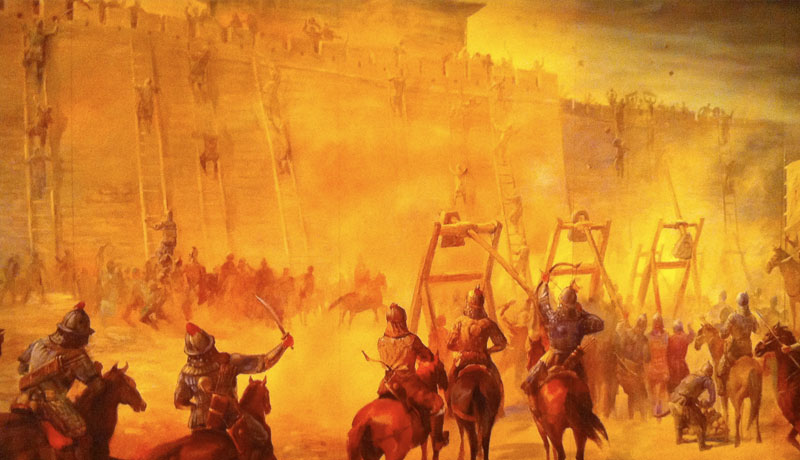Herbst Theatre, 401 Van Ness Avenue, San Francisco
In the 13th century, Genghis (Chingis) Khan (Universal Ruler) led a nomadic East Asiatic people in the creation of the largest contiguous empire in the history of the world. In the wake of his military victories, the essence of Asian culture spread throughout the conquered lands, the Silk Road that linked China via Central Asia to Europe was reopened, papermaking and printing technologies were introduced to the West, and a comprehensive communications network was established (one of whose imitators, centuries later, was America’s Pony Express). Although his reputation as a brutal warrior is infamous, in recent years the contributions of his Empire in art, science, religious tolerance, commerce and politics, as well as military strategy, have gained more recognition. An able administrator himself, Genghis Khan, his sons and grandsons ruled the region from China to Europe for 150 years.
Tuesday, February 19, 2008
Mechanics’ Institute, 57 Post Street, San Francisco
Special Event
Open to the public. $10 general admission.
Free to cooperating institutions and supporters of Humanities West.
5:30 pm reception
6:00 pm lecture
Portraits of Chingis Khan and Art of Mongol Empire.
Pre-performance Lecture on the Art of Mongolia by Orna Uranchimeg-Tsultem (ABD, Art History, UC Berkeley).
The lecture will discuss portraits of Chingis (Genghis) Khan and some selected works of Mongolian art during the imperial period. Were the Mongols “barbarians” or patrons and creators of fine art? Did the Mongol rulers build cities or always ruined and destroyed? Also some contemporary images of Chingis Khan will be discussed and analyzed.
The Mechanics’ Institute is a Humanities West Cooperating Institution.
Friday, February 22, 2007
Herbst Theatre, 401 Van Ness Avenue, San Francisco
Moderator, Fred Astren Director, Jewish Studies Program, San Francisco State University
Preliminaries
Keynote Address The ‘owl of misfortune’ or the ‘phoenix of prosperity”? Reassessing Chingis Khan and the Mongol Empire
Daniel Waugh, Emeritus Professor, University of Washington
To some of their contemporaries, the conquest of Eurasia by Chingis (Genghis) Khan and his successors in the thirteenth century was the worst disaster which had ever befallen mankind. How did much of Eurasia come to be ruled from Mongolia? Were the Mongols uniquely destructive? This presentation will attempt to separate myth from reality and provide a balanced picture of the Mongols’ impact on their contemporary world.
Lecture/Demonstration From Steppe to Stage: An Exploration of 800 Years of Mongolian Music
Presented by Peter K. Marsh, Assistant Professor of Music, CSU East Bay
Mongolian music, song, and dance are closely tied to the traditional pastoral nomadic ways of life of the Mongol peoples. Even the music performed in the refined and cosmopolitan courts of Kubilai Khan was rooted back in the lives of the Mongol nomads. In this lecture, we’ll explore the history of Mongolian music from Imperial times to the present paying particular attention to how traditional music, including the two-stringed fiddle and khöömii or ‘throat singing’ traditions, intersects the human, natural, and spiritual worlds. We’ll end by looking at how Mongolian music has fared in the era of globalization. With a demonstration by Orgilsaikhan Chimeddorj playing on the morin khuur or ‘horse-head fiddle,’ and Ulziisaikhan Lkhagvadorj playing on the ever büree or ‘Mongolian horn’ and singing khöömii or a ‘throat-singing’ style.
Saturday, February 23, 2007
Herbst Theatre, 401 Van Ness Avenue, San Francisco
Lecture Culture and Commerce
Morris Rossabi, Professor of History, Columbia University
The image of Chingis (Genghis) Khan and the Mongols as barbarians intent on plunder and destruction is still widely held. The brutality of their military campaigns should not be ignored, but this slide-illustrated lecture reveals that they promoted commerce and fostered some of the arts in the vast empire they subjugated.
Lecture The Women in Genghis’s Life
James Ryan, Emeritus Professor, CCNY
“The Women in Chingis Khan’s Life.” In Chingis (Genghis) Khan’s era, Mongol women enjoyed higher position and greater recognition than those in China, the Arab world, or Europe, as commentators from those societies frequently noted. This was especially true of Mongol Katuns, the consorts of the khans, who played major political roles in the Mongol Empire and the various khanates that succeeded it. Surviving records reveal much about them and the society in which they wielded power. This presentation will focus on several of these remarkable women, including Chingis’ mother, his chief wife and mother of the four sons who figured in succession to his empire, and several of his daughters-in-law.
Performance Mongolian Music
A presentation of Mongolian Music, coordinated by Peter Marsh and Orna Uranchimeg-Tsultem, withOrgilsaikhan Chimeddorj on the morin khuur or ‘horse-head fiddle,’ and Ulziisaikhan Lkhagvadorj on the ever büree or ‘Mongolian horn’ and singing khöömii or a ‘throat-singing’ style.
Lecture The Mongol Influence on Islamic, especially Persian, Art (an illustrated account)
Stefano Carboni, Curator, Islamic Art, Metropolitan Museum of Art New York
During the century-long period of the unified Mongol confederacy, people, objects, and ideas moved with unprecedented freedom over the entire vast Asian territory, including the Islamic areas of Western Asia. The confluence of previously distant cultures yielded a bold new visual aesthetic that would resonate in Islamic art for centuries to come. The lecture will explore the impact of China’s Yüan dynasty on the art and culture of Iran’s Ilkhanid dynasty, a period of great cultural achievement and profound changes as local artists and artisans were introduced to previously unknown artistic traditions from East Asia and attempted to respond to the tastes of their new royal patrons, the Mongol rulers.
Panel Discussion
Moderated by Fred Astren
Presenters
Stephano Carboni, Art, Metropolitan Museum of Art
Peter Marsh, Musicology, California State East Bay
Morris Rossabi, History, Columbia
James Ryan, History, City College New York
Uranchimeg Tsultem, Musicians
David Waugh, History, U Washington
